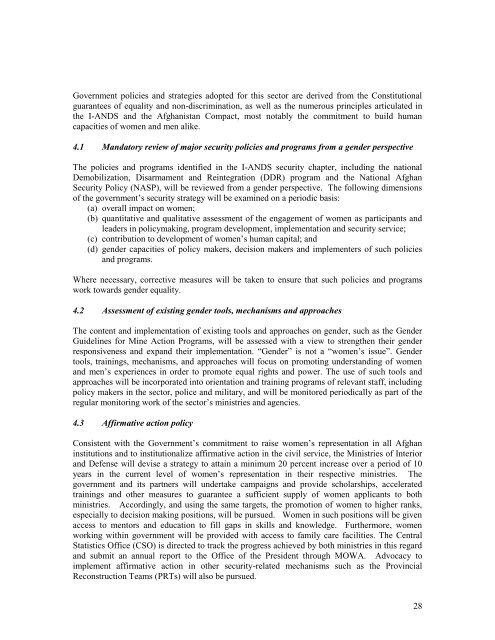National Action Plan for the Women of Afghanistan - The Secretary ...
National Action Plan for the Women of Afghanistan - The Secretary ...
National Action Plan for the Women of Afghanistan - The Secretary ...
- No tags were found...
You also want an ePaper? Increase the reach of your titles
YUMPU automatically turns print PDFs into web optimized ePapers that Google loves.
Government policies and strategies adopted <strong>for</strong> this sector are derived from <strong>the</strong> Constitutional<br />
guarantees <strong>of</strong> equality and non-discrimination, as well as <strong>the</strong> numerous principles articulated in<br />
<strong>the</strong> I-ANDS and <strong>the</strong> <strong>Afghanistan</strong> Compact, most notably <strong>the</strong> commitment to build human<br />
capacities <strong>of</strong> women and men alike.<br />
4.1 Mandatory review <strong>of</strong> major security policies and programs from a gender perspective<br />
<strong>The</strong> policies and programs identified in <strong>the</strong> I-ANDS security chapter, including <strong>the</strong> national<br />
Demobilization, Disarmament and Reintegration (DDR) program and <strong>the</strong> <strong>National</strong> Afghan<br />
Security Policy (NASP), will be reviewed from a gender perspective. <strong>The</strong> following dimensions<br />
<strong>of</strong> <strong>the</strong> government‘s security strategy will be examined on a periodic basis:<br />
(a) overall impact on women;<br />
(b) quantitative and qualitative assessment <strong>of</strong> <strong>the</strong> engagement <strong>of</strong> women as participants and<br />
leaders in policymaking, program development, implementation and security service;<br />
(c) contribution to development <strong>of</strong> women‘s human capital; and<br />
(d) gender capacities <strong>of</strong> policy makers, decision makers and implementers <strong>of</strong> such policies<br />
and programs.<br />
Where necessary, corrective measures will be taken to ensure that such policies and programs<br />
work towards gender equality.<br />
4.2 Assessment <strong>of</strong> existing gender tools, mechanisms and approaches<br />
<strong>The</strong> content and implementation <strong>of</strong> existing tools and approaches on gender, such as <strong>the</strong> Gender<br />
Guidelines <strong>for</strong> Mine <strong>Action</strong> Programs, will be assessed with a view to streng<strong>the</strong>n <strong>the</strong>ir gender<br />
responsiveness and expand <strong>the</strong>ir implementation. ―Gender‖ is not a ―women‘s issue‖. Gender<br />
tools, trainings, mechanisms, and approaches will focus on promoting understanding <strong>of</strong> women<br />
and men‘s experiences in order to promote equal rights and power. <strong>The</strong> use <strong>of</strong> such tools and<br />
approaches will be incorporated into orientation and training programs <strong>of</strong> relevant staff, including<br />
policy makers in <strong>the</strong> sector, police and military, and will be monitored periodically as part <strong>of</strong> <strong>the</strong><br />
regular monitoring work <strong>of</strong> <strong>the</strong> sector‘s ministries and agencies.<br />
4.3 Affirmative action policy<br />
Consistent with <strong>the</strong> Government‘s commitment to raise women‘s representation in all Afghan<br />
institutions and to institutionalize affirmative action in <strong>the</strong> civil service, <strong>the</strong> Ministries <strong>of</strong> Interior<br />
and Defense will devise a strategy to attain a minimum 20 percent increase over a period <strong>of</strong> 10<br />
years in <strong>the</strong> current level <strong>of</strong> women‘s representation in <strong>the</strong>ir respective ministries. <strong>The</strong><br />
government and its partners will undertake campaigns and provide scholarships, accelerated<br />
trainings and o<strong>the</strong>r measures to guarantee a sufficient supply <strong>of</strong> women applicants to both<br />
ministries. Accordingly, and using <strong>the</strong> same targets, <strong>the</strong> promotion <strong>of</strong> women to higher ranks,<br />
especially to decision making positions, will be pursued. <strong>Women</strong> in such positions will be given<br />
access to mentors and education to fill gaps in skills and knowledge. Fur<strong>the</strong>rmore, women<br />
working within government will be provided with access to family care facilities. <strong>The</strong> Central<br />
Statistics Office (CSO) is directed to track <strong>the</strong> progress achieved by both ministries in this regard<br />
and submit an annual report to <strong>the</strong> Office <strong>of</strong> <strong>the</strong> President through MOWA. Advocacy to<br />
implement affirmative action in o<strong>the</strong>r security-related mechanisms such as <strong>the</strong> Provincial<br />
Reconstruction Teams (PRTs) will also be pursued.<br />
28
















